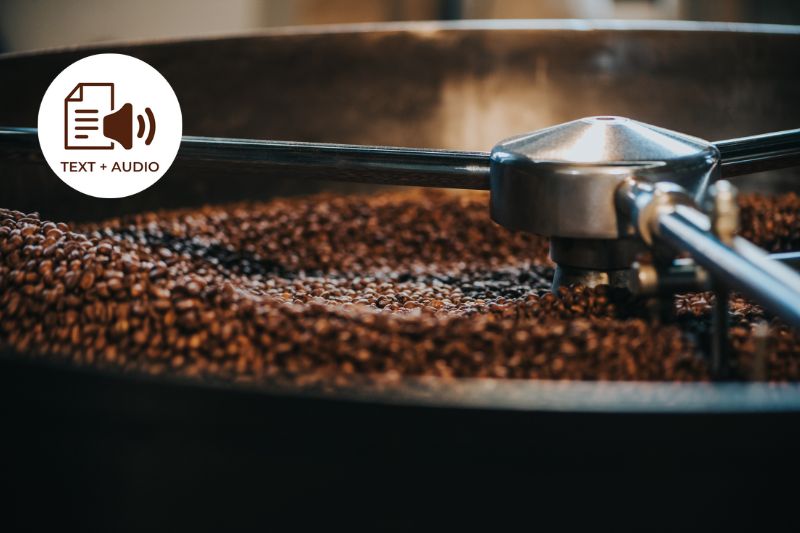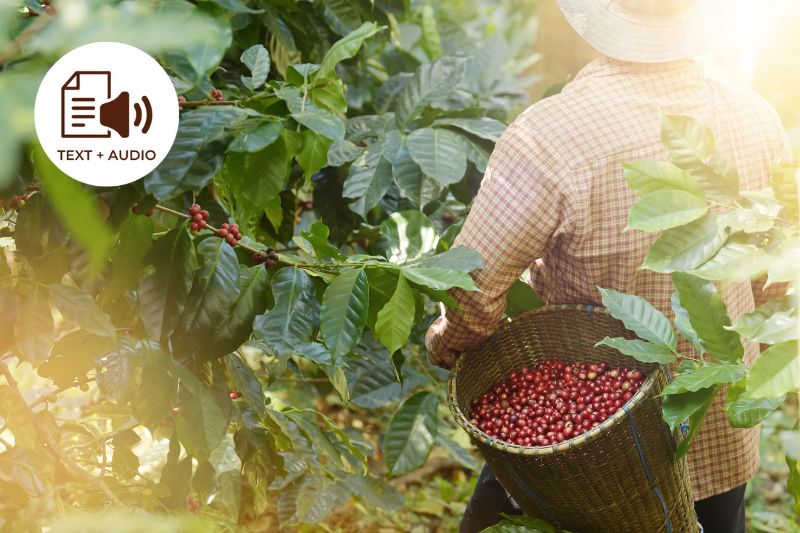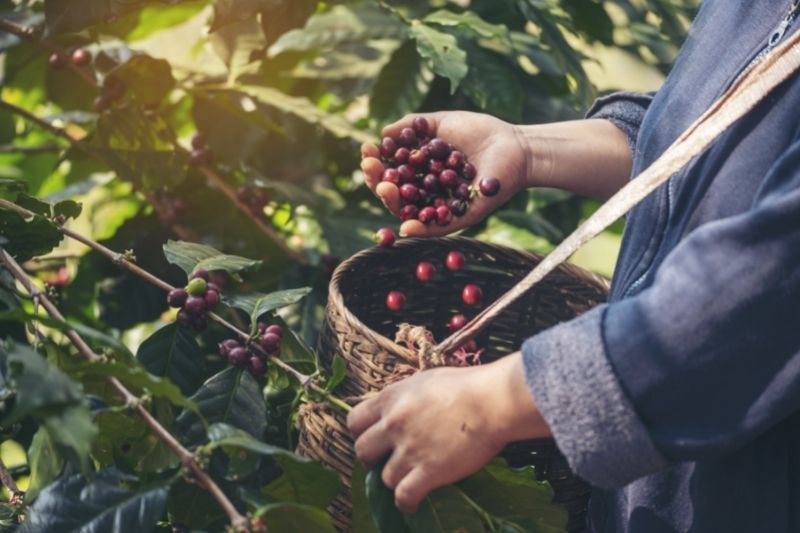Premium coffee is like good wine or exceptional tea. Each individual coffee cherry only thrives as well as its growing conditions allow. The soil, the location, the climate, and the cultivation methods—all of these are important prerequisites for producing top-quality green coffee.
Today, I am going to talk to you about the ways that soil and other factors affect the taste of your coffee.

The terroir can have a major influence on the taste of a cup of coffee. What is the soil like in which the coffee plants grow? How many hours of sun are there during harvest time? How much is the rainfall?
All of these factors influence the cultivation of coffee and the character that a coffee from a particular region ultimately has.
When it comes to wine, we can clearly distinguish between Riesling, Chardonnay, and Pinot Noir. When it comes to growing coffee of different varieties, there are often differences not only between different countries but also between different growing areas and regions within a country.
In addition to the soil cultivation, the harvesting method and, in particular, the subsequent processing of the coffee cherries also have a major influence on the aromas of the coffee.
How Soil affects the Taste of Coffee
The coffee belt offers the perfect climate for growing coffee beans, because coffee needs a very warm climate and a very specific environment in order to grow. To produce the best possible beans, coffee trees must be grown at great heights in humid, tropical climates with dry and rainy seasons and on fertile soils.
Other factors that influence the quality and taste of the coffee are the variety of the plant, the quality of the soil, and the way in which the fruits of the coffee plant are processed after they are harvested. In fact, the combination of factors is so complex that quality and taste can vary dramatically even within a single plantation.
Soil is where it all begins, and like any other agricultural product, the conditions need to be ideal for the coffee plant to grow to its full potential.
The ideal soil
Coffee plants need nutrient-rich soil and are most comfortable with a slightly acidic pH value between 5 and 6. Ethiopia's volcanic soils offer some of the best growing conditions in the world.
Planting large mulch grass will help maintain moisture, but it should be removed when the seeds are fully germinated. The soil should always be well drained, but it should always remain moist.

Fertilizer can also be added after germination. A fertilizer that is suitable for orchids can be used sparingly for the coffee plant. This creates a low mineral content and a low pH value.
A rich, peat-based potting mix with excellent drainage is beneficial. Coffee plants don't like calcareous soils. So if the plant isn't thriving, some peat should be added.
A Tea Example
To help you understand better why rich, nutrient-rich, and well-maintained soil is so important to coffee, I will give you a parallel example regarding tea.
Chagusaba is a traditional Shizuoka tea cultivation method. The tea fields are surrounded by partially natural grass fields, which mainly consist of dwarf bamboo and silver grass. In autumn, these grasses are cut off, dried, and brought to the tea fields as a mixture.
The soil climate is improved, moisture is better retained, and the natural fertilizer is regulated. A particularly desirable side effect is that the tea becomes more aromatic and sweeter.
Much like the Chagusaba method, there are other methods that coffee farmers rely on to keep their soil rich in nutrients and ensure it maintains an ideal pH. This way the coffee plant has the chance to grow to its full potential and absorb all the unique elements from the soil.
These elements then translate to individually amazing coffee aromas and flavors that are unique to the region and sometimes the farm that the coffee grew in.
Soil Quality in large Coffee Plantations
For the sake of economy, commodity coffee beans are usually grown on large plantations. However, these cannot meet all of the above-mentioned optimal growth conditions for the sensitive coffee plant.
This is why “plantation coffee” often does not achieve the first-class coffee taste that can be achieved with the best possible care in cultivation. This coffee is mostly grown in monocultures on large plantations.

This means, on the one hand, that the coffee bushes are exposed to the blazing sun and, on the other hand, that the soil is leached out very quickly.
And coffee is also quite peculiar with regard to the nature of the soil; it should be loose, nutrient-rich soil if possible. Only good soil ensures a promising coffee taste because the sensitive coffee plants get all the nutrients.
Large plantations may be economical, but they are not the best choice for coffee, the environment, or social conscience.
Other Factors that affect the Taste of Coffee
Coffee is a product of nature; therefore, climatic changes in the growing areas are the main reason why the green coffee from one region tastes slightly different from year to year or from cultivation to cultivation.
Let’s take a look at some other factors that affect the taste of coffee aside from soil quality:
1. Hours of sunshine
The best growing conditions for coffee plants can be found around the equator, as it is pleasantly warm there but not too hot.

2. Amount of precipitation
Coffee plants grow particularly well with high humidity and regular rainfall (approximately 1,500–2,000 liters per square meter), as the plants absorb a large part of the liquid they need through their leaves.
If there is enough water, brightly colored flowers can develop, which ensures that the coffee cherries develop well—the basis for high-quality and tasty coffee.
If it is too rainy during a harvest season, the coffee cherries will burst, and the risk of phenol increases. If there is not enough rain, the harvest will be worse because the yield will decrease.
3. Location
Another important factor for the cultivation—and thus the taste—is the location of a growing area. The ideal combination of sunlight and precipitation can be found on slopes or in forest gardens, so cultivation areas are particularly common there.
The higher a coffee-growing area is, the lower the average temperature there. This combination ensures that the coffee cherries grow more slowly and can develop better.

The aromas of the coffee beans become more intense and stronger. Coffee plants that are grown at altitudes above 1000 meters are called "highland coffees."
4. Diversity of cultivated varieties & plant growth in the area
A fourth point, which differs from growing area to growing area and therefore influences the taste, is the variety of coffee varieties grown, as well as the general plant growth in the area.
For example, if coffee plants grow in mixed forests, the various trees and bushes can protect each other from pests, which makes the use of environmentally harmful fertilizers and pesticides unnecessary.
Coffee cherries ripen for almost a full year in some areas, such as the Ethiopian highlands. From planting to harvest, it takes up to ten months for the cherries to turn their original green into yellow and finally into a strong red.
Only a red, ripe coffee cherry yields aromas in green coffee. There are also varieties whose ripe cherries are yellow. Here, too, coffee cultivation is very individual, from region to region.
Final Thoughts
Isn’t it surreal to think about all the different factors that have affected the aroma and taste of the coffee you have in your cup? Many farmers in the coffee belt take great pride in the way they take care of their soil and the coffee’s natural environment all the way from cultivation to harvest.
Farms like these usually produce excellent-quality premium coffee. If knowing all this makes you even more curious, then it’s time to try premium coffee and learn the farming history behind your cup. You’ll be surprised by how much there is to discover!
Get Free Bonus Books

Sign up for free to the Coffee Club to get advice and exclusive articles about how to choose Japanese Coffee, and tips, tricks, and recipes for enjoying Japanese coffee.
About the author
Kei Nishida
Author, CEO Dream of Japan
Certification: PMP, BS in Computer Science
Education: Western Washington University
Kei Nishida is a passionate Japanese tea and coffee connoisseur, writer, and the founder and CEO of Japanese Coffee Co. and Japanese Green Tea Co., both part of Dream of Japan.
His journey began with a mission to introduce the world to the unparalleled quality of Japanese green tea. Through Japanese Green Tea Co., he established the only company that sources premium tea grown in nutrient-rich sugarcane soil—an innovation that led to multiple Global Tea Champion awards.
Building on this success and his passion for Japanese craftsmanship, Kei expanded into the world of coffee, pioneering the launch of Japanese Coffee Co., the first company to bring Sumiyaki charcoal-roasted coffee to a global audience. His dedication to authenticity and quality ensures that this traditional Japanese roasting method, once a well-kept secret, is now enjoyed worldwide.
Beyond tea and coffee, Kei has also introduced Japan’s legendary craftsmanship to the world through Japanese Knife Co., making handmade katana-style knives—crafted by a renowned katana maker—available outside Japan for the first time.
Kei’s journey continues as he seeks out and shares the hidden treasures of Japan, one cup and one blade at a time.
Learn more about Kei












